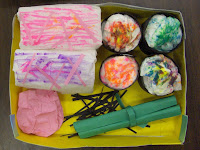secondary: 30 students of secondary 3&4 between 15 and 17 years old | John F Kennedy High School (Montreal) | January to April 2011
PROJECT: PAPER SCULPTURE
DURATION: 4-5 sessions
KEY CONCEPTS: form,
sculpture, tearing, ripping, curling, folding, moulding, cutting, planes
MATERIALS:
´
Paper
´
Scissors
´
Glue
´
Tape
FEATURED ARTISTS
´
Wet folding
(developed by Akira Yoshizawa)
´
Pureland (developed
by John Smith)
o Simple origami
´
Lukasheva
Ekaterina
o Echinos (2009)
o Bird (2010)
o Gloriosa (2009)
o Septima (2010)
´
Junior Fritz
Jacket
o Masks
o Coralys
o Bonhomme Cannelle
´
Neiman Marcus
o Pop up book (2007)
´
Jim Woodring
o Pulpit (2007)
o Jungle Head (2007)
o Cage (2007)
´
Peter Callesen
o Fall (2008)
o Impenetrable Castle (2005)
´
Jeff Nishinaka
o Ana Hotel, Tokyo: for 5th opening
anniversary
o Nisei Week Festival, Little Tokyo, Los angeles
´
Ingrid Siliakus
o 4th of a series inspired by Escher (1999)
o
Palicio del Marques de Salamanca (2007)
o
Signature Revived (2008)
´
Eric Joisel
o Arle
o Orange Fish
´
Richard Sweeney
o Shell (2010)
o Figure (2002)
STEPS
- Exploration:
class #1
SIDE ACTIVITY:Origami is
paper art. Literally translated from Japanese, it means paper folding. Set up
stations where students can come fold origami to get acquainted with paper as a
medium for sculpture.
At some point during the
class, watch how the artists in the FEATURED ARTISTS (I created a slideshow on
a DVD with all the images) section use paper to create a work out of simple
materials. Notice the differences between each and their different levels of
complexity. So much can be done with only paper.
FOR HOMEWORK: find 3
reference images that will help you create your paper sculpture project. You
can bring in images from magazines or photos, or printed from the computer. If
you don’t have access to a printer, sketch out your 3 references and bring them
to next class.
- Prep:
class #2
SIDE ACTIVITY: you have 5
minutes to run around the class and its surroundings (cafeteria and corridor)
to go make some rubbings of different textures. Watch how the paper reacts: the
relief you are creating on your paper is called embossing.
You need to have a plan:
´
start by
sketching what your final product will look like, from 2 different angles. Make
sure it has a minimum of 5 planes or 3 dimensions. For example: you can make a
star or a character (3d objects) or you can create a layered scene with
background, middle grounds, and foreground. Think of how adding light can
affect your image. Do you want to play with the transparency of your paper, or
will the light serve to give it a more 3d look?
´
Next, figure out
a color scheme for your sculpture. Remember to use contrast and harmony: your
most important element needs to stand out (using contrast) and your surrounding
elements must appear to blend in together (that’s harmony).
´
You then need to
make 2 lists: one of the materials you’ll need for this project, and one should
be a list of the step you’ll be taking to create your art piece (you should
also include the amount of time each step is going to take you).
- Final
work: class #3 & 4
SIDE ACTIVITY: paper mache:
Have a table covered with newspaper with a canvas or wooden board set up.
Include a bucket of paper mache paste (either flour and water, or diluted glue
or medium) and strips of newspaper. Encourage the students to build up a structure
from the board upward.
Start your final piece. Use
the materials and steps from your plan to create it. You have 2 periods to work
on this.
NOTE: You might be allowed a
third period to work on this depending on how the first two periods go.
NOTE: if a student has no
idea, give them a project to do: get them to choose 3 reference images from
National Geographic magazines (they should be landscapes). From this
inspiration, they must make a 3D maquette with at least 5 planes.
- Justification:
class #5 (or 6)
Hand this in as a short
paper or list to accompany your final work.
These questions must be
answered:



No comments:
Post a Comment